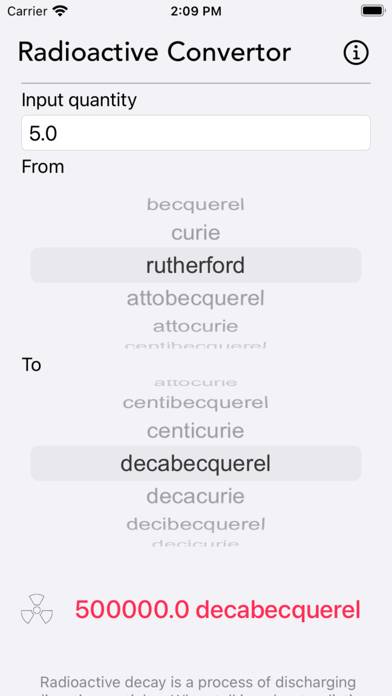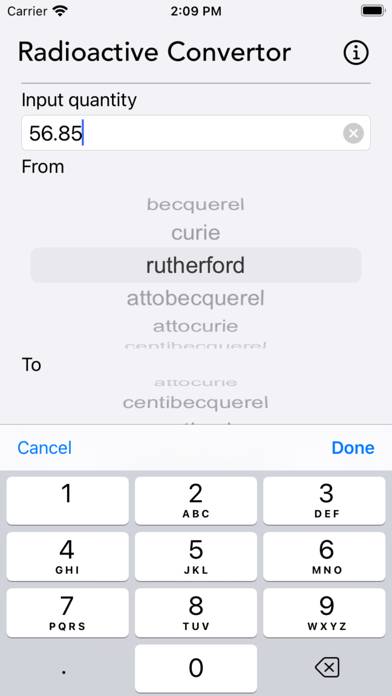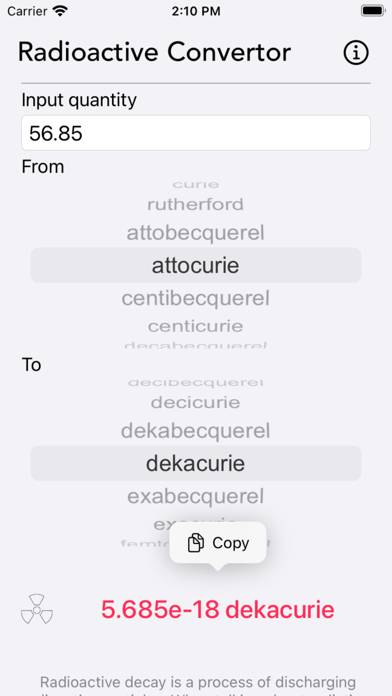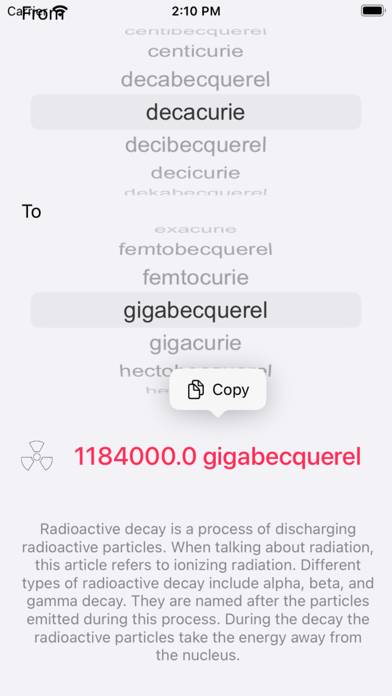How to Delete Radioactivity Conversion
Published by: NitrioRelease Date: September 26, 2023
Need to cancel your Radioactivity Conversion subscription or delete the app? This guide provides step-by-step instructions for iPhones, Android devices, PCs (Windows/Mac), and PayPal. Remember to cancel at least 24 hours before your trial ends to avoid charges.
Guide to Cancel and Delete Radioactivity Conversion
Table of Contents:




Radioactivity Conversion Unsubscribe Instructions
Unsubscribing from Radioactivity Conversion is easy. Follow these steps based on your device:
Canceling Radioactivity Conversion Subscription on iPhone or iPad:
- Open the Settings app.
- Tap your name at the top to access your Apple ID.
- Tap Subscriptions.
- Here, you'll see all your active subscriptions. Find Radioactivity Conversion and tap on it.
- Press Cancel Subscription.
Canceling Radioactivity Conversion Subscription on Android:
- Open the Google Play Store.
- Ensure you’re signed in to the correct Google Account.
- Tap the Menu icon, then Subscriptions.
- Select Radioactivity Conversion and tap Cancel Subscription.
Canceling Radioactivity Conversion Subscription on Paypal:
- Log into your PayPal account.
- Click the Settings icon.
- Navigate to Payments, then Manage Automatic Payments.
- Find Radioactivity Conversion and click Cancel.
Congratulations! Your Radioactivity Conversion subscription is canceled, but you can still use the service until the end of the billing cycle.
How to Delete Radioactivity Conversion - Nitrio from Your iOS or Android
Delete Radioactivity Conversion from iPhone or iPad:
To delete Radioactivity Conversion from your iOS device, follow these steps:
- Locate the Radioactivity Conversion app on your home screen.
- Long press the app until options appear.
- Select Remove App and confirm.
Delete Radioactivity Conversion from Android:
- Find Radioactivity Conversion in your app drawer or home screen.
- Long press the app and drag it to Uninstall.
- Confirm to uninstall.
Note: Deleting the app does not stop payments.
How to Get a Refund
If you think you’ve been wrongfully billed or want a refund for Radioactivity Conversion, here’s what to do:
- Apple Support (for App Store purchases)
- Google Play Support (for Android purchases)
If you need help unsubscribing or further assistance, visit the Radioactivity Conversion forum. Our community is ready to help!
What is Radioactivity Conversion?
Optional radioactivtity conversion problems:
Radioactive decay is the process of emitting radioactive particles, particularly ionizing radiation. Various types of radioactive decay include alpha, beta, and gamma decay, named after the particles emitted during this process. As decay occurs, radioactive particles carry energy away from the nucleus. In some cases, radioactive decay can transform the original nucleus into either a different nucleus or a nucleus in an altered state.
Radioactivity is a property exhibited by certain elements, where the atomic nucleus spontaneously loses electromagnetic energy due to its inherent instability. This phenomenon was first discovered in 1896 by the French physicist Antoine-Henri Becquerel. During this process, ionizing particles and electromagnetic radiation are emitted from the nucleus. Many elements exhibit natural radioactivity.
The duration for radiation to undergo decay varies between elements and their isotopes, often measured in terms of a half-life. The half-life signifies the time it takes for an element's radiation to decrease to half of its initial intensity. Certain elements like uranium and thorium continuously emit radiation and ionizing particles, leading to the formation of different daughter elements while releasing energy in the form of alpha, beta, and gamma radiation.
One particularly significant radioactive element is Radon, a dense, colorless, and odorless gas with a boiling point of -61.8°C (-79.2°F). Radon readily dissolves in water below its boiling point and can freeze at low temperatures.